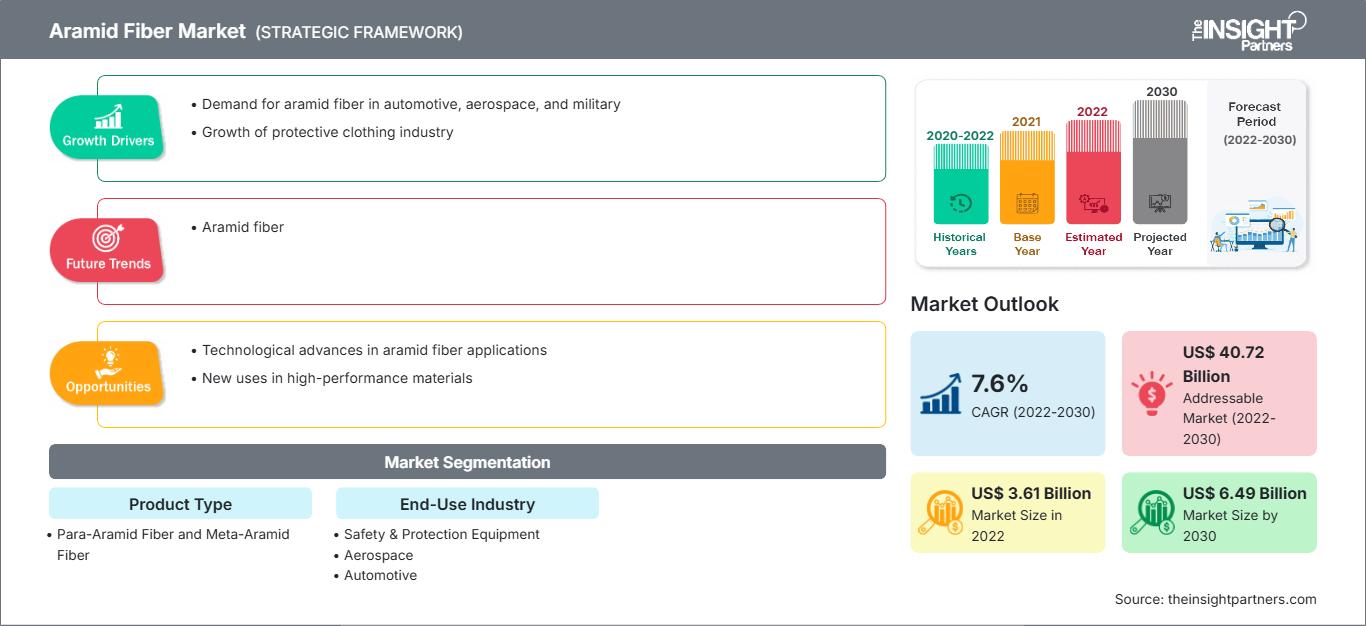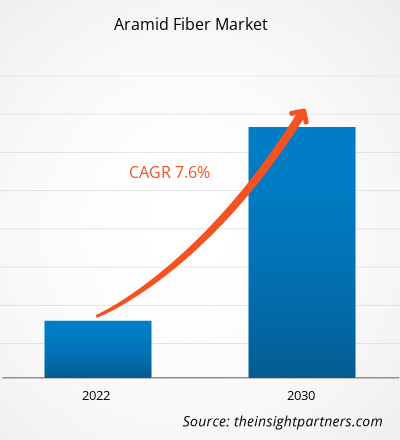[調査レポート]アラミド繊維市場規模は2022年に36億1,000万米ドルと評価され、2030年までに64億9,000万米ドルに達すると見込まれています。また、2022年から2030年にかけて7.6%のCAGRで成長すると予測されています。
市場分析とアナリストの見解:
アラミド繊維は芳香族ポリアミドとも呼ばれ、優れた強度、耐熱性、耐久性を備えた合成繊維です。鋼鉄の5~6倍という高い引張強度と、鋼鉄のわずか5分の1という軽量性で知られています。これらの優れた特性により、これらの繊維は幅広い用途、特に高性能と安全性が求められる業界で価値のあるものとなっています。アラミド繊維の独特な構造が、その優れた特性に大きく貢献しています。これらの繊維はポリアミド分子の長い鎖で構成されており、アミド結合が芳香族環に直接結合しています。この構造により、繊維に優れた強度と剛性を与える剛性の棒状構造が形成されます。さらに、芳香族環は固有の耐熱性と安定性を提供するため、これらの繊維は大きな劣化なしに高温に耐えることができます。
成長の原動力と課題:
自動車業界からの需要の増加は、アラミド繊維市場の拡大を後押しする大きな原動力となっています。自動車メーカーがより軽量で燃費の良い車両の生産に注力するにつれて、これらの繊維の需要は飛躍的に増加しています。これらの繊維、特にケブラーを含むパラアラミド系の繊維は、高い強度対重量比を備えているため、構造的完全性を損なうことなく軽量部品を開発することができます。自動車分野では、これらの繊維はタイヤ、ブレーキ、パッド、複合材料の製造など、さまざまな用途に広く使用されています。これらの繊維で部品を補強することで、耐久性と耐摩耗性が向上し、長寿命化と全体的な性能向上に貢献します。さらに、これらの繊維は自動車用複合材の製造にも利用されており、燃費目標の達成に不可欠な強度と重量のバランスを実現します。このように、これらすべての要因が自動車分野におけるアラミド繊維の需要を押し上げています。
しかし、アラミド繊維市場は、類似または代替の特性を持つ代替品の存在により、成長に限界が生じています。炭素繊維は、これらの繊維の主要な代替品の一つであり、高強度や軽量性など、アラミド繊維といくつかの特性を共有しています。特定の用途、特に優れた剛性や導電性を持つ材料を求める場合、メーカーは代替品として炭素繊維を選択することがあります。こうした代替品との競争は、特に両方の材料が必要な仕様を満たす可能性のある業界において、これらの繊維の普及にとって課題となっています。
要件に合わせてレポートをカスタマイズ
レポートの一部、国レベルの分析、Excelデータパックなどを含め、スタートアップ&大学向けに特別オファーや割引もご利用いただけます(無償)
アラミド繊維市場: 戦略的洞察

- このレポートの主要な市場動向を入手してください。この無料サンプルには、市場動向から見積もりや予測に至るまでのデータ分析が含まれます。
レポートの一部、国レベルの分析、Excelデータパックなどを含め、スタートアップ&大学向けに特別オファーや割引もご利用いただけます(無償)
アラミド繊維市場: 戦略的洞察

- このレポートの主要な市場動向を入手してください。この無料サンプルには、市場動向から見積もりや予測に至るまでのデータ分析が含まれます。
レポートのセグメンテーションと範囲:
「2030年までの世界のアラミド繊維市場分析」は、世界中の市場動向と成長機会に重点を置いた専門的かつ詳細な調査です。本レポートは、製品タイプと最終用途産業別に詳細な市場セグメンテーションを行い、市場の概要を提供することを目的としています。市場は近年高い成長を遂げており、予測期間中もこの傾向が続くと予想されています。本レポートは、世界のアラミド繊維消費に関する主要な統計を提供します。さらに、本レポートは、世界のアラミド繊維市場のパフォーマンスに影響を与えるさまざまな要因の定性的な評価を提供します。また、本レポートには、市場の主要プレーヤーとその主要な戦略的展開に関する包括的な分析も含まれています。市場のダイナミクスに関する複数の分析も含まれており、主要な推進要因、市場動向、有利な機会を特定して、主要な収益ポケットを特定するのに役立ちます。
エコシステム分析とポーターの 5 つの力の分析により、市場の 360 度のビューが提供され、サプライ チェーン全体と、世界のアラミド繊維市場の成長に影響を与えるさまざまな要因を理解するのに役立ちます。
セグメント分析:
製品タイプに基づいて、市場はパラアラミド繊維とメタアラミド繊維に分かれています。最終用途産業の点では、市場は安全および保護機器、航空宇宙、自動車、電子機器および通信、その他に分割されています。安全および安全保護機器セグメントは、2022年にアラミド繊維の大きな市場シェアを記録しました。アラミド繊維、特にケブラーなどのパラアラミドの変種は、並外れた強度、高弾性率、耐衝撃性で知られており、安全性と保護が最優先される用途に最適です。この繊維は、防弾チョッキやヘルメットの製造に広く使用されています。これらの繊維の固有の弾道抵抗と軽量性が相まって、防弾チョッキに好まれる選択肢となっています。世界中の軍隊と法執行機関は、機動性を損なうことなく弾道の脅威から人員を効果的に保護するために、アラミドベースの防護具を広く使用しています。これらすべての要因が、安全および保護機器セグメントのアラミド繊維市場を牽引しています。
地域分析:
地理に基づいて、アラミド繊維市場は、北米、ヨーロッパ、アジア太平洋、南米および中米、中東およびアフリカの5つの主要地域に分割されています。市場はアジア太平洋地域が独占しており、2022年には約10億米ドルを占めました。この地域には、市場の成長機会が豊富に存在します。外国直接投資の増加も、この地域の経済成長につながっています。自動車部品、電子機器など、多くの用途でこれらの繊維の使用が増えていることから、アジア太平洋地域におけるアラミド繊維の需要が増加すると予想されています。
ヨーロッパは、2022年から2030年にかけて8.0%を超えるCAGRを記録すると予想されています。アラミド繊維は、航空機の構造や防弾システムにおける軽量でありながら堅牢な部品の製造に不可欠です。ヨーロッパは、大手航空宇宙企業や重要な防衛部門の本拠地であるため、これらの業界におけるアラミド繊維の需要は増加し続けています。さらに、北米は2030年に約17億米ドルに達すると予想されています。
業界の発展と将来の機会:
アラミド繊維市場で活動している主要企業によるさまざまな取り組みを以下に示します。
- 2023年4月、デュポン・ド・ネムール社はケブラーEXOTMアラミド繊維の発売を発表しました。ケブラーEXOは、軽量性、柔軟性、アラミド繊維の保護を兼ね備えており、生命の保護を最初の用途としています。
アラミド繊維アラミド繊維市場の地域別分析
アラミド繊維市場の地域別分析
予測期間を通じてアラミド繊維市場に影響を与える地域的な動向と要因については、The Insight Partnersのアナリストが詳細に解説しています。このセクションでは、北米、ヨーロッパ、アジア太平洋、中東・アフリカ、中南米におけるアラミド繊維市場のセグメントと地域についても解説しています。
アラミド繊維市場レポートの範囲
| レポート属性 | 詳細 |
|---|---|
| の市場規模 2022 | US$ 3.61 Billion |
| 市場規模別 2030 | US$ 6.49 Billion |
| 世界的なCAGR (2022 - 2030) | 7.6% |
| 過去データ | 2020-2022 |
| 予測期間 | 2022-2030 |
| 対象セグメント |
By 製品タイプ
|
| 対象地域と国 | 北米
|
| 市場リーダーと主要企業の概要 |
|
アラミド繊維市場のプレーヤー密度:ビジネスダイナミクスへの影響を理解する
アラミド繊維市場は、消費者の嗜好の変化、技術の進歩、製品の利点に対する認知度の高まりといった要因により、エンドユーザーの需要が高まり、急速に成長しています。需要の増加に伴い、企業は製品ラインナップの拡充、消費者ニーズへの対応、そして新たなトレンドの活用を進めており、これが市場の成長をさらに加速させています。

- 入手 アラミド繊維市場 主要プレーヤーの概要
COVID-19の影響:
COVID-19パンデミックは、様々な国のほぼすべての産業に悪影響を及ぼしました。北米、ヨーロッパ、アジア太平洋(APAC)、南米および中米、中東およびアフリカ(MEA)でのロックダウン、渡航制限、事業停止は、化学および素材産業を含むいくつかの産業の成長を阻害しました。アラミド繊維企業の製造ユニットの閉鎖は、世界のサプライチェーン、製造活動、および納期に混乱をもたらしました。多くの企業が、2020年に製品の納品の遅延と製品販売の低迷を報告しました。ほとんどの工業製造施設はパンデミック中に閉鎖され、これらの繊維の消費が減少しました。さらに、COVID-19パンデミックはアラミド繊維の価格変動を引き起こしました。しかし、供給制約が解決された後、様々な産業が操業を再開し、それがプラスチック容器市場の回復につながりました。さらに、自動車業界からのこれらの繊維に対する需要の高まりが、アラミド繊維市場の成長を大きく促進しています。
競争環境と主要企業:
デュポン・ド・ヌムール社、帝人株式会社、煙台大和先端材料社、暁星株式会社、東レ株式会社、コーロン・インダストリーズ、ヒュービス社、中国藍星集団有限公司、泰光工業株式会社、ケルメル社は、世界のアラミド繊維市場で活動する主要企業です。これらのグローバル企業は、顧客の需要を満たす高品質な製品の提供に注力しています。
- 過去2年間の分析、基準年、CAGRによる予測(7年間)
- PEST分析とSWOT分析
- 市場規模価値/数量 - 世界、地域、国
- 業界と競争環境
- Excel データセット
最新レポート
関連レポート
お客様の声
購入理由
- 情報に基づいた意思決定
- 市場動向の理解
- 競合分析
- 顧客インサイト
- 市場予測
- リスク軽減
- 戦略計画
- 投資の正当性
- 新興市場の特定
- マーケティング戦略の強化
- 業務効率の向上
- 規制動向への対応






















 無料サンプルを入手 - アラミド繊維市場
無料サンプルを入手 - アラミド繊維市場